

Junto: overview of concept, philosophy, and components. Hi all!

In the past few months, there has been a lot of excitement and momentum building around the Junto concept, which has been great, and expanded all of our views of where it could go. I just wanted to take the time to reclarify the philosophy, definition, and components of Junto, so that we know what steps can be carried out to bring the vision closer to a reality.
Thanks again for everyone’s involvement in this collective learning and building process! Junto :: philosophy. Chance and choice experiences, presencing as community art. Andrew Campbell wrote somewhere, “The more whole and integrated each person the chances for choices are increased…” I may have found that sentence in the context of his conversation with de Lange on the Learning Organizations list, 5 years ago.
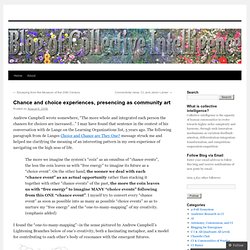
The following paragraph from de Langes Choice and Chance are They One? Bohm Dialogue. Bohm Dialogue (also known as Bohmian Dialogue or "Dialogue in the Spirit of David Bohm") is a freely-flowing group conversation in which participants attempt to reach a common understanding, experiencing everyone's point of view fully, equally and nonjudgementally.[1] This can lead to new and deeper understanding.
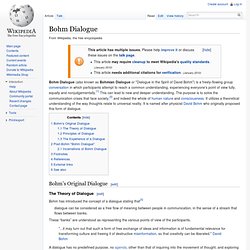
The purpose is to solve the communication crises that face society,[2] and indeed the whole of human nature and consciousness. It utilizes a theoretical understanding of the way thoughts relate to universal reality. It is named after physicist David Bohm who originally proposed this form of dialogue. Bohm's Original Dialogue[edit] The Co-Inteligence Institute. Dialogue Conversation is thinking in its natural state.
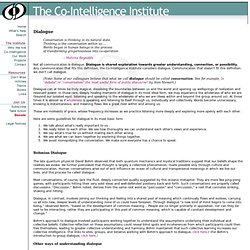
Thinking is the conversation within us.... Words began in human beings in the process of transforming gregariousness into co-operation. -- Malvina Reynolds Not all communication is dialogue. (Note: Some of our colleagues believe that what we call dialogue should be called conversation. How to Design Culture: 16 Patterns to Build Adaptive Learning Organizations. How do we form learning cultures in times of accelerating change?

What tools and practices can self-organizing structures implement to become more agile and adaptive? I just received a copy of a new book by Dan Mezick called The Culture Game, which is all about answering the above inquiry. It touts itself as “the reference manual and toolbox for management “culture hackers,” those innovators and change-makers who are focused on creating a culture of learning inside their team…and the wider organization.”
I’ve known Dan now for the better part of this year, and he’s been feeding me these tips, which are totally changing the ways I approach my own personal growth and development, as well as how I’m interacting with others. For me, the culture hacking movement really gets to the essence of how to build/become a learning organization and transform the future of work. Kurt Lewin. Action research. Action research is either research initiated to solve an immediate problem or a reflective process of progressive problem solving led by individuals working with others in teams or as part of a "community of practice" to improve the way they address issues and solve problems.
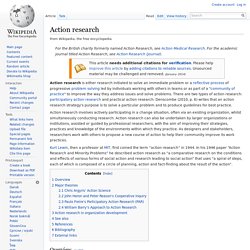
There are two types of action research: participatory action research and practical action research. Denscombe (2010, p. 6) writes that an action research strategy's purpose is to solve a particular problem and to produce guidelines for best practice. Action research involves actively participating in a change situation, often via an existing organization, whilst simultaneously conducting research. Join us for the first Social Innovation Lab. Human Systems Dynamics Institute. M A R G A R E T J. W H E A T L E Y. Otto Scharmer. Presencing Institute. Collective Wisdom Initiative home page. Ideas & Networks. A Scientific and Philosophical Assessment: The singularity as a phase transition (extended abstract)
Béla Nagy, Santa Fe InstituteJ.Doyne Farmer, Santa Fe Institute John Paul Gonzales, Santa Fe Institute The Finite Time Singularity Scenario In his seminal article about “The Coming Technological Singularity” Vinge (1993) quotes how Ulam (1958) paraphrased John von Neumann as saying: “One conversation centered on the ever accelerating progress of technology and changes in the mode of human life, which gives the appearance of approaching some essential singularity in the history of the race beyond which human affairs, as we know them, could not continue.”

Of course, we can only guess exactly what kind of singularity the great Hungarian-born American mathematician had in mind, but one such guess is a finite time singularity, i.e. a mathematical singularity that can occur by trying to divide with zero. Graphically, this can be illustrated by a hyperbola approaching a vertical asymptote at the time of the singularity, such as 1/x approaching infinity as x goes to zero. References LEVITIN, L. The Best Definition of Singularity. The term Singularity has many definitions.
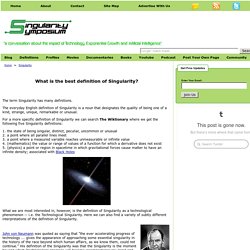
A Taxonomy of Singularities: Comparing the Literature on Systems of Accelerating Change. A Preliminary Singularity Taxonomy: Six Types Briefly, the following six singularity types, in four apparent general classes (mathematical, physical, computational, and developmental), each have their own semi-independent literature.
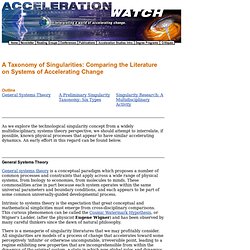
Comparing and contrasting them can be quite illuminating. 1. Mathematical singularities (the oldest singularity literature available) are systems of equations that lead, under certain conditions, to infinities, uncomputability, or irreversible emergences.